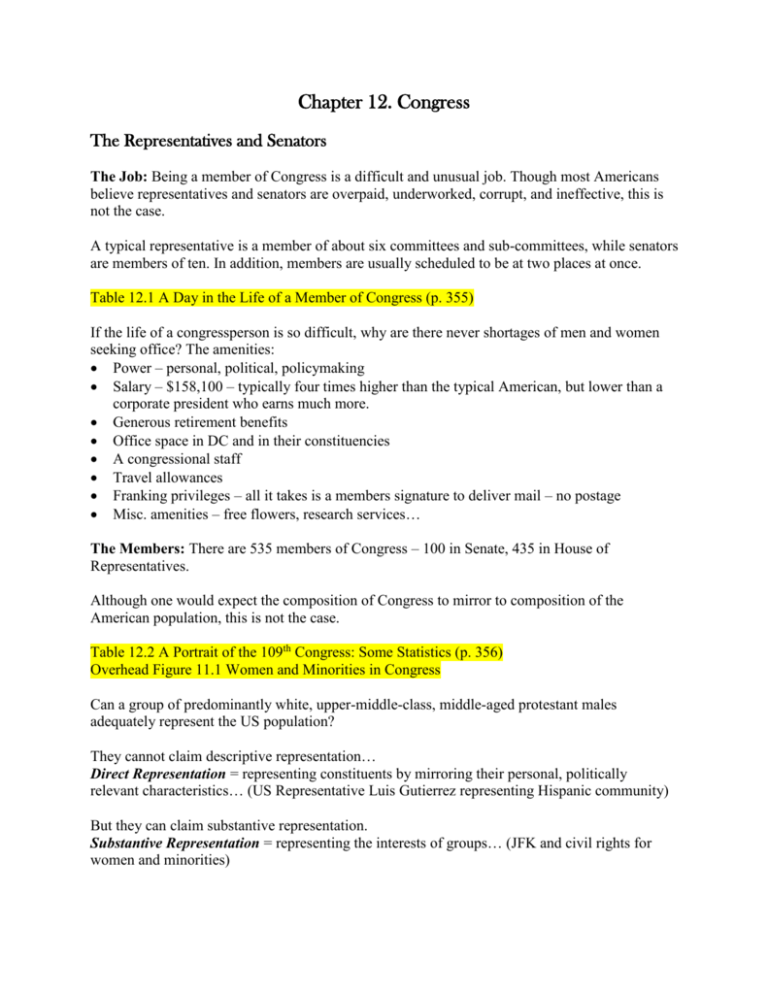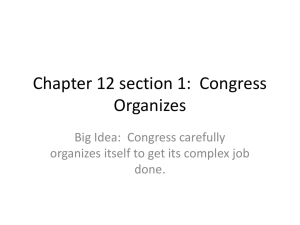Chapter 12 – Notes
advertisement

Chapter 12. Congress The Representatives and Senators The Job: Being a member of Congress is a difficult and unusual job. Though most Americans believe representatives and senators are overpaid, underworked, corrupt, and ineffective, this is not the case. A typical representative is a member of about six committees and sub-committees, while senators are members of ten. In addition, members are usually scheduled to be at two places at once. Table 12.1 A Day in the Life of a Member of Congress (p. 355) If the life of a congressperson is so difficult, why are there never shortages of men and women seeking office? The amenities: Power – personal, political, policymaking Salary – $158,100 – typically four times higher than the typical American, but lower than a corporate president who earns much more. Generous retirement benefits Office space in DC and in their constituencies A congressional staff Travel allowances Franking privileges – all it takes is a members signature to deliver mail – no postage Misc. amenities – free flowers, research services… The Members: There are 535 members of Congress – 100 in Senate, 435 in House of Representatives. Although one would expect the composition of Congress to mirror to composition of the American population, this is not the case. Table 12.2 A Portrait of the 109th Congress: Some Statistics (p. 356) Overhead Figure 11.1 Women and Minorities in Congress Can a group of predominantly white, upper-middle-class, middle-aged protestant males adequately represent the US population? They cannot claim descriptive representation… Direct Representation = representing constituents by mirroring their personal, politically relevant characteristics… (US Representative Luis Gutierrez representing Hispanic community) But they can claim substantive representation. Substantive Representation = representing the interests of groups… (JFK and civil rights for women and minorities) Congressional Elections Overall, congressional elections are demanding and expensive. Who Wins Elections? Everyone in Congress is a politician, and politicians continuously have their eyes on the next elections. Everyone in congress is also an incumbent. Incumbents: those already holding office. In congressional elections, incumbents usually win. Overhead Figure 5.2 The Power of Incumbency House: 90% Rule: 90% of House incumbents run for reelection, and 90% usually win; why? Represent smaller more homogenous constituency; greater contact with constituents. Senate: Senators usually win by narrow margins; why? Represent heterogeneous state, with larger constituency base. They also spend less time in the state and are less visible than Representatives. However, they tend to gain greater media coverage. Despite their success at reelection, incumbents usually feel vulnerable. Consequently, they raise and spend more campaign funds, send more mailings to their constituents, visit their states and districts more often, and staff more local offices than every before. The Advantage of Incumbency: What accounts for the success of congressional incumbents? Advertising: advertising means more than placing an ad in a newspaper or on television. Most advertising takes place between elections, in the form of contact with constituents. The goal is visibility. They send mass mailings to constituents, and they visit their district/state often. Credit Claiming: congressmen engage in credit claiming by enhancing their standing with constituents through service to individuals and the district. Casework: helping constituents as individuals; cutting through red tape to get people what they think they have a right to get. Pork Barrel: list of federal projects, grants, and contracts available to cities, business, colleges and institutions. Overhead Process Box 5.1 How Members of Congress Represent Their Districts Other factors impacting congressional elections: Position Taking: all members of congress must take policy stands, and the positions they take may affect the outcome of an election. This is especially the case for senators who represent a larger and more diverse constituency base. Therefore, incumbents tend to emphasize non-partisan personal qualities such as congressional experience, hard-working, trustworthiness… Weak Opponents: another advantage for incumbents is that they will likely face weak opponents. Those individuals who run are usually unknown, unqualified, and inexperienced. The lack of adequate campaign funding also weakens a challenger’s goal of unseating an incumbent. Campaign Spending: it costs a great deal of money to run for congress; in 2001-2002, congressional candidates spend nearly a billion dollars to get reelected. Challengers have to raise large sums of money if they are to defeat incumbents; the more money they spend, the more votes they will get. Why? Money buys them name recognition and a chance to be heard. Ultimately, the candidate who spends the most money typically wins… and this is normally the case for incumbents. Overhead Figure 11.3 Campaign Money Spend by Incumbents, Challengers, and Open-Seat Candidates, 1998 Overhead Figure 5.3 House and Senate Campaign Expenditures, 1980-2000 The Role of Party Identification: although party loyalty at the voting booth is not as strong as it was a generation ago, it is still a good predictor of voting behavior. Most members of congress represent constituencies in which their party is in the majority. Defeating Incumbents: although incumbents have a large advantage, challengers have been successful in unseating many incumbents. Why? Scandals, corruption, negative publicity can ruin the reelection chances of an incumbent. Redistricting may cause an incumbent to lose their districts / home base. Partisan shifts occasionally role across the country. (1994, frustration with Democrats led to major gains for Republicans) Open Seats: most congressional turnover is due to vacated seats. In these cases, incumbents chose not to run for reelection; the field is open for new candidates from both parties to step in. How Congress is Organized to Make Policy Of all the roles of congressmen, the most difficult is policymaking. This tends to be the case because congressmen are policy generalists trying to make policy on specialized topics. Members are also short on time and expertise; they are amateurs on almost all subjects. The founders tried to tackle this problem by splitting congress into the senate and House of Representatives. Congress had tried to cope with these problems by creating an elaborate committee system. American Bicameralism: a bicameral legislature is a legislature divided into two houses. The US Congress and every state legislature (with the exception of Nebraska) are bicameral. Differences between US House of Representatives and US Senate: Overhead Table 11.1 Constitutional Differences Between the House and the Senate Table 12.3 House Versus Senate: Some Key Differences (p. 365) Senate & Procedures: Filibuster: an activity unique to the Senate; a tactic by which opponents of a bill use their right to unlimited debate as a way to prevent the senate from ever voting on a bill. Once senators have the floor in a debate, they can talk as long as they want. (Senator Strom Thurmond once held the floor for 24 hours – civil rights legislation. Senators can even read the phone book to kill time…) Cloture: 60 senators present and voting can halt a filibuster. Congressional Leadership: although congressmen are powerful, there are a few positions in the House and Senate which provide a higher level of prestige; and these positions are determined by the political parties. House: the chief leadership position in the House is the Speaker of the House. Speak of the House: legislative office mandated by constitution; the majority party selects the speaker – usually someone with a long history in the House; the speaker is the second in line to the presidency (first being the VP). J Dennis Hastert (IL, Rep) elected speaker in 1999, member of House since 1987. Duties: preside over the House when in session, plays a major role in committee assignments, appoints party leaders, controls which bills get assigned to which committees. Majority Leader: The speakers partisan ally is the majority leader; the party’s manager in the House. Roy Blunt (Republican, Missouri) Temp for Tom Delay (Republican, Texas) Duties: scheduling bills, influencing committee assignments, and rounding up votes in behalf of the party’s legislative position. Stepping stone to Speaker of the House position. Whips: party leaders who work with the majority or minority leaders to count votes beforehand and lean on waverers whose votes are crucial to a bill favored by the party. Minority party is also posed to take over the Speaker of the House position and Majority Leader post should they win the majority of seats in the next election. Minority Leader: the principle leader of the minority party in the House or in the Senate. Nancy Pelosi, Democrat, California Duties: similar duties to majority leader. Senate: as defined by the constitution, the president of the Senate is the Vice President – Dick Cheney; this is the only defined job of the VP. VP’s usually slight their duties in the Senate, leaving the Senate party leaders to take control. Senate Majority Leader: aided by the majority whip, carries our party goals, corals votes, schedules floor action, and influences committee assignments. Bill Frist, Tennessee, Republican Senate Minority Leader: similar duties to majority leader. Harry Reid, Nebraska, Democrat The Committees and Subcommittees: committees hold hearings, investigate problems and possible wrongdoing, and oversee the executive branch. There are four types of committees: Standing Committees: formed to handle bills in different policy areas. Each house of congress has its own standing committees; members do not belong to a committee in the other house. Table 12.4 Standing Committees in the Senate and in the House (p. 369) Joint Committees: exist in few policy areas like the economy and taxation; membership is drawn from House and Senate. Conference Committees: formed when the Senate and the House pass a particular bill in different forms. Appointed by party leadership, a conference committee consists of members of each house chosen to iron out Senate and House differences and to report back a compromise bill. (House and Senate bills must be identical.) Select Committees: appointed for specific purposes. (ex. the senate select committee that investigated Watergate) Caucuses: the Information Organization of Congress: there are over 300 caucuses in congress, and the goal of each caucus is to promote their interests. Congressional Caucus: a group of members of Congress sharing some interests or characteristic. Most are composed of members from both parties and both houses. Ex. Black Caucus, Hispanic Caucus, Women’s Caucus, Democratic Caucus, Republican Caucus… Overall, the explosion of these informal groups has made representation in congress a more direct process. The Congressional Process Although almost 11,000 bills are introduced into Congress each year, most bills are killed in Committee. Bill: a proposed law, drafted in precise legal language. Anyone can draft a bill – the White House, interest groups, even you and I; however, only members of the House and Senate can formally submit a bill for consideration. Figure 12.2 How a Bill Becomes a Law (p. 377) – Detailed Version Overhead Figure 11.8 How a Bill Becomes a Law – Condensed Version For a bill to become a law, it must eventually win at least eleven legislative victories… In one House Subcommittee In the full House Committee In the House Rules Committee (to move to the floor) In the House floor In one Senate Subcommittee In the full Senate Committee On the Senate floor In the House Senate conference committee (to produce identical bills) Back to the House floor for final passage Back to the Senate floor for final passage Presidential decision (signs or vetoes bill) Law (if signed by president) Conclusion As noted by the constitution, members of congress are the government’s policymakers; however, congressmen have other roles besides creating public policy… they are also politicians concerned with reelection. Therefore, constituency services – casework and pork barrel – become critical for incumbents. The structure of congress itself is also complex. Its bicameral division means that it is more difficult to have a bill become law, than to have a bill die. Lastly, although congress may have some undemocratic and unrepresentative features, members do tend to pay attention to popular preferences. In fact, congress does not impose programs on a reluctant public, they respond to public demands for these programs.









